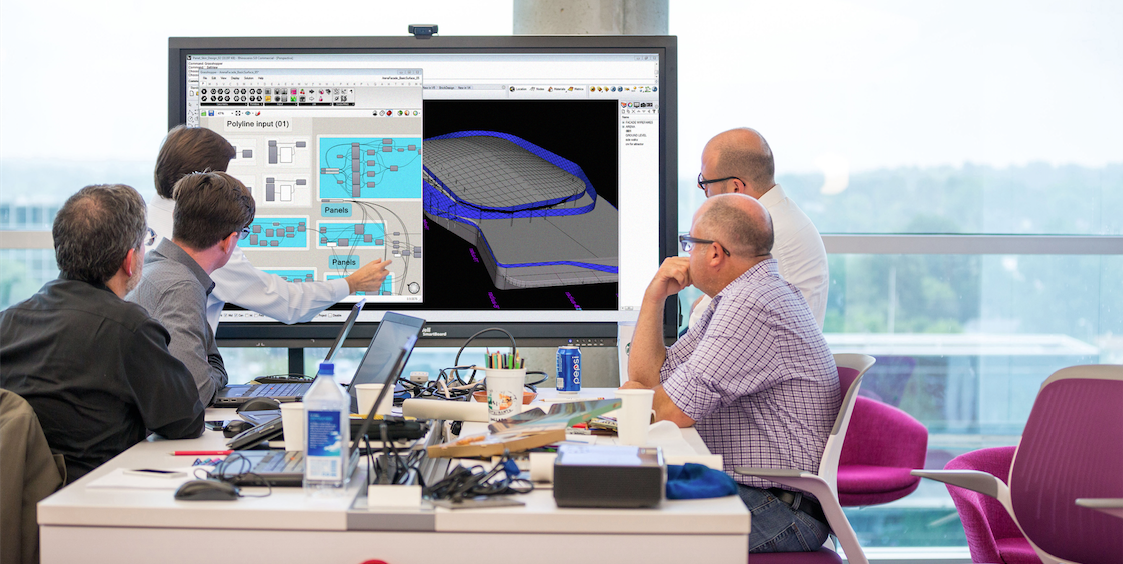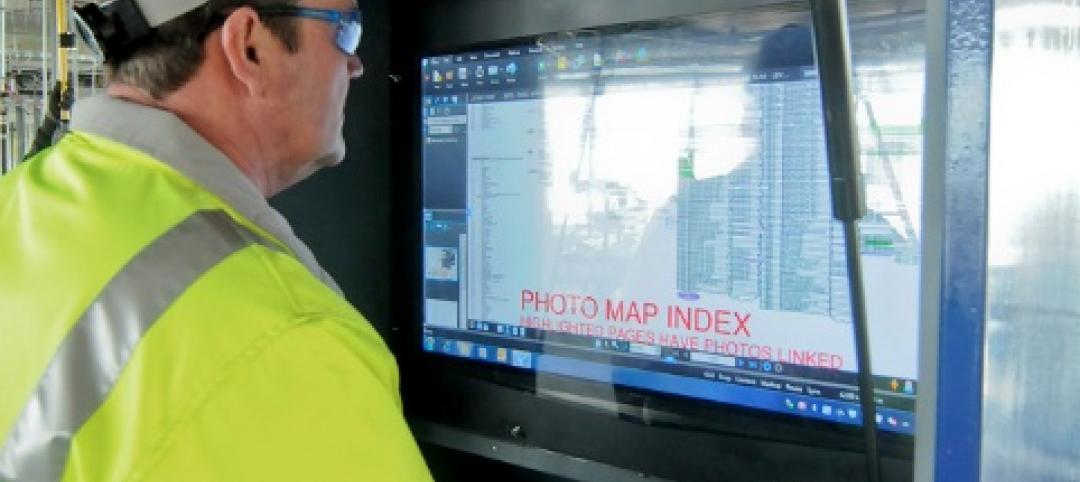Should architects learn to code? This question was posed by computational design consultant Nathan Miller, Founder and Managing Director of Proving Ground, in a recent blog post about the rise of data-driven design. Miller’s answer: “Well, maybe.”
While Miller and other computation experts don’t expect every design professional to become Mark Zuckerberg in “The Social Network” (“Don’t interrupt him. He’s plugged in!”), there is no denying the growing importance of the utilization of data and computation in the design process. HDR, NBBJ, Populous, Thornton Tomasetti, and Woods Bagot are among the firms that are investing in talent and training to advance their CD capabilities.
ALSO SEE
6 ways smart AEC firms are using computational design methods
During his four-plus years as a CD consultant, Miller has assisted these firms and others in developing a business roadmap for breaking into data-driven design. We asked him for tips and advice on getting started. He offered the following:
1. Define the business value of computational design. Computational design is an open-ended methodology, not a class of software tools with predefined features for a specific uses.The value of computation is greatly dependent on how well an AEC organization positions the new skill sets, tools, and workflows relative to the business.
“I’m often confronted with questions akin to some variation of, ‘Can Grasshopper or Dynamo do X,’” says Miller. “The reality is quite the opposite: Computational design is about the process of creating solutions. The question is better framed as, ‘What can we create that will help us better solve X design problem?’”
It could involve developing an algorithm that can greatly increase the speed of solving repetitive design problems, or creating a tool for a project or market that can provide an advantage for a firm looking to differentiate its services in a competitive marketplace.
For CD to be meaningful to a business at scale means determining the desired outcomes, coupled with a strategic framework for developing a team capable of creating high-impact solutions, says Miller.
2. Pilot computational design services in the areas where your firm takes the most risks. AEC firms tend to be risk adverse when it comes to changing process. Factor in increasingly tighter deadlines and shrinking fees, and it can make computational design a hard sell to firm leaders.
‘Design organizations should be looking for do-it-yourself creative thinkers that have a knack for making digital tools.’
—Nathan Miller, Proving Ground
Miller says a number of his AEC clients have had success winning over firm leaders and scaling up CD operations by piloting these tools and processes in the areas of the practice where the firm traditionally takes more risks, namely project pursuits, RFPs, and design competitions.
“When you know you’re going up against strong competition and you want to take some calculated risks, those become very good entry points for computational design,” says Miller. “By going the computation route with an RFP or competition submission, it may allow the firm to explore a problem a little differently, or capture that process and fold it into the overall narrative.”
Win a few projects and light bulbs will start going off throughout the practice.
3. Hire for passion of building design, not for coding prowess. It’s much tougher to teach a game designer or software engineer about the building design process than it is to teach an architect or engineer basic coding skills. Many firms, however, are looking to the tech markets—computer science, simulation, software engineering, game development—to build their CD teams.
“Where the real moment with computational design concepts comes to bear is when you engage the opposite—give a couple of designers who are really passionate about buildings the skills to be able to code,” says Miller.
He has advised AEC clients to modify their job requisitions for entry-level designers coming out of school to include skill sets like experience with computational design software. “If you’re a firm looking to grow your CD capability, you need to change the demographic of the people applying for the position,” says Miller.
4. Invest in people, not software. Computational design software is a drop in the bucket compared to the six- and seven-figure investments firms have had to make in CAD and BIM software tools. Grasshopper is a free plug-in. Dynamo is open source. The tools are essentially free. The real investment is in finding the right people and then advancing their computation capabilities.
“As with most things that drive success in service organizations, people should be the focus of business investment for executing a successful computational design strategy,” says Miller. “Design organizations should be looking for do-it-yourself creative thinkers that have a knack for making digital tools.”
5. Apply the 70/20/10 ratio when assembling your computation-enabled design team. While no two firms are the same, Miller has discovered a sweet spot for the makeup of computation-enabled design teams: the 70/20/10 ratio. Seventy percent should have enough working knowledge to be able to “pull the levers” on pre-made computational tools; 20% should have a high comfort level with building simple tools and modifying complex project algorithms; 10% should have an advanced skill set in creating sophisticated tools and solutions.
Having a team with a range of skill sets, says Miller, will encourage broader participation, skill growth, and engagement across the organization.
Project leaders and firm management need to be active participants in the implementation process. “They don’t need to know the nuts and bolts of the tools, but they do need to understand how the project process is changing so they can give the team a platform to deliver valuable design solutions,” says Miller.
For more on computational design, read Proving Ground’s blog.
Related Stories
| Dec 9, 2013
Does technology help or hinder innovation?
Whether digital technology will help or hinder workplace insights remains a topic of ongoing debate. FastCo.Design features insights from business scholars on both sides of the issue.
| Dec 5, 2013
Translating design intent from across the globe
I recently attended the Bentley User Conference in Vejle, Denmark. I attended the event primarily to get a sense for the challenges our Danish counterparts are experiencing in project delivery and digital communication. One story I heard was from a BIM manager with Henning Larsen Architects in Denmark, who told me about a project she’d recently completed overseas in the Middle East. She outlined two distinct challenges and offered some interesting solutions to those challenges.
| Dec 3, 2013
‘BIM for all’ platform pays off for contractor
Construction giant JE Dunn is saving millions in cost avoidances by implementing a custom, cloud-based BIM/VDC collaboration platform.
| Nov 27, 2013
Exclusive survey: Revenues increased at nearly half of AEC firms in 2013
Forty-six percent of the respondents to an exclusive BD+C survey of AEC professionals reported that revenues had increased this year compared to 2012, with another 24.2% saying cash flow had stayed the same.
| Nov 25, 2013
Electronic plan review: Coming soon to a city near you?
With all the effort AEC professionals put into leveraging technology to communicate digitally on projects, it is a shame that there is often one major road block that becomes the paper in their otherwise “paperless” project: the local city planning and permitting department.
| Nov 22, 2013
Kieran Timberlake, PE International develop BIM tool for green building life cycle assessment
Kieran Timberlake and PE International have developed Tally, an analysis tool to help BIM users keep better score of their projects’ complete environmental footprints.
| Nov 8, 2013
Can Big Data help building owners slash op-ex budgets?
Real estate services giant Jones Lang LaSalle set out to answer these questions when it partnered with Pacific Controls to develop IntelliCommand, a 24/7 real-time remote monitoring and control service for its commercial real estate owner clients.
| Oct 30, 2013
Why are companies forcing people back to the office?
For a while now companies have been advised that flexibility is a key component to a successful workplace strategy, with remote working being a big consideration. But some argue that we’ve moved the needle too far toward a “work anywhere” culture.
| Oct 30, 2013
11 hot BIM/VDC topics for 2013
If you like to geek out on building information modeling and virtual design and construction, you should enjoy this overview of the top BIM/VDC topics.
| Oct 18, 2013
Meet the winners of BD+C's $5,000 Vision U40 Competition
Fifteen teams competed last week in the first annual Vision U40 Competition at BD+C's Under 40 Leadership Summit in San Francisco. Here are the five winning teams, including the $3,000 grand prize honorees.

















